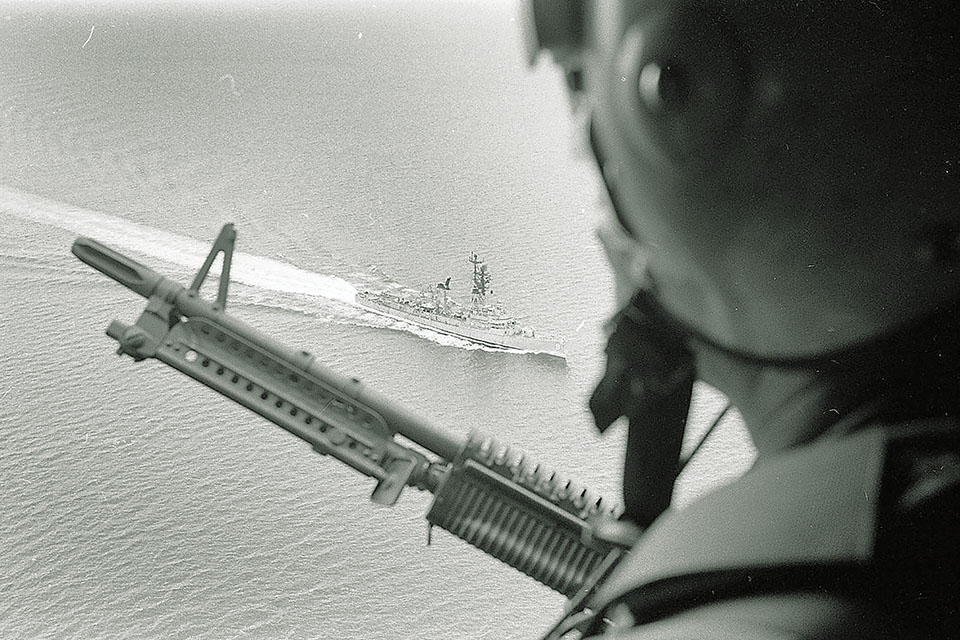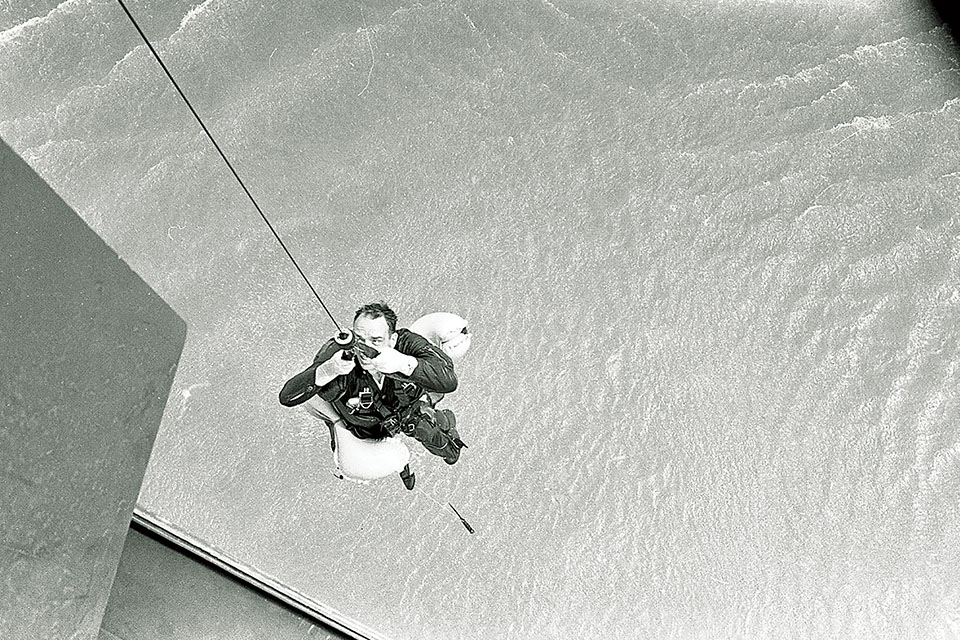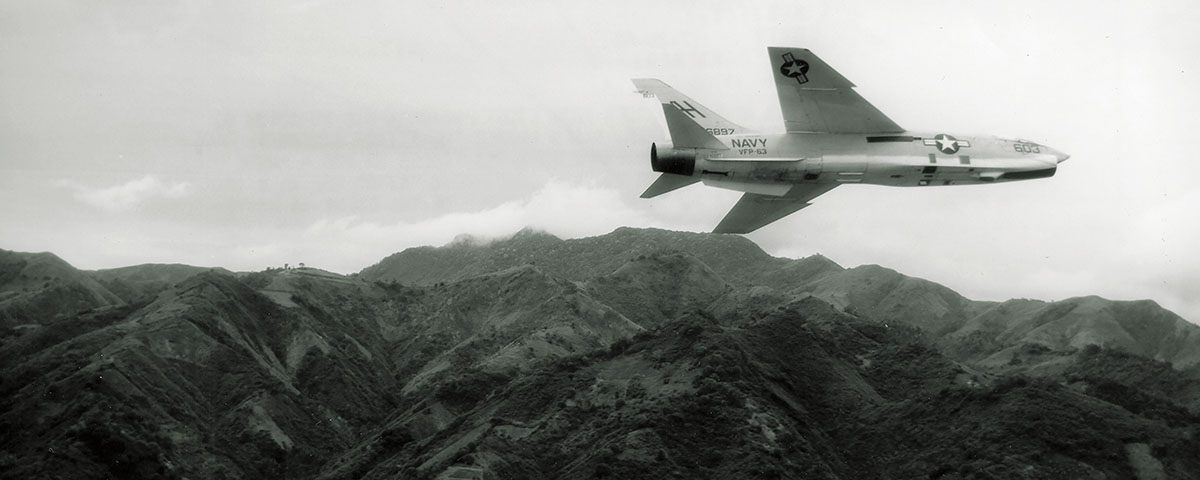In 1966 a U.S. Navy helicopter crew plucked a downed aviator from North Vietnam’s busiest harbor in one of the war’s most daring rescues
On the morning of Aug. 31, 1966, Aviation Photographer’s Mate 2nd Class Mike Delamore boarded a tubby U.S. Navy amphibious helicopter with his camera and plenty of film. He expected to shoot a typical day in a chopper crew’s life flying combat search and rescue (CSAR) over the Gulf of Tonkin. The mission initially offered little excitement. Hours of boredom piled up as the four-man crew flew lazy patterns near Yankee Station—the point in the ocean from which American carriers launched aircraft into North Vietnam exchanging small talk with their passenger, mugging for his camera and waiting for a distress call.
But Delamore soon found himself in a combat photographer’s dream position, witness to one of the most spectacular rescues of the Vietnam War—a downed pilot plucked from the water in broad daylight in plain view of the enemy despite withering ground fire and a host of other dangers. Newspapers worldwide reprinted Delamore’s photos of the rescue.
The story behind his photos begins with a different kind of aerial photography assignment.
Not long after Delamore got airborne that last day of August 1966, Lt. Cmdr. Thomas Tucker catapulted from the deck of the aircraft carrier USS Oriskany (CVA-34) in his Vought RF-8G Crusader on a photoreconnaissance mission. Tucker’s mission prep had begun the night before, when he reviewed requirements from the Military Assistance Command, Vietnam (MACV), based outside Saigon, detailing the types of photos the brass wanted and the location of the target. He determined which cameras and what kind of film he would use, picked up maps of the area, planned his flight and got some sleep before his briefing from Oriskany’s Air Intelligence Office two hours before takeoff the next morning.
Operation Rolling Thunder, the sustained aerial bombing of North Vietnam, was in its second year, and members of Light Photographic Squadron 63 (VFP-63), scattered across Southeast Asia in small detachments, had played a key role in the campaign. In the era before reliable satellite imagery, the U.S. military’s fast jets gathered much of the raw intelligence on troop movements, weapons installations, bomb damage and so on. As commander of VFP-63’s Detachment G, Tucker had already flown more than 30 such photorecon missions into North Vietnam. Half an hour before launch he did the preflight check on Corktip 602, the call sign and tail number of the Vought RF-8G Crusader he would fly that day. Soon the carrier turned into the wind, and Tucker blasted into the air with a boost from a steam catapult. Once airborne Tucker checked in with Lt. Cmdr. Foster “Tooter” Teague, who was flying escort in an armed Crusader. They proceeded north.
To keep from being blown from the sky, a pilot flying the specially equipped RF-8G depended on three tactical advantages: speed, maneuverability and superior mission planning. The single-seat photorecon jet could scream through a combat zone at nearly 1,000 miles per hour, and although it carried no weapons, it still boasted the fast-twitch handling of a state-of-the-art fighter. Moreover, without the weight of rockets, missiles or guns, the modified plane’s extended range allowed its pilot to use the main payload—six high-speed cameras—to maximum effect. These aviators made great use of their own aerial intelligence to map the topography, radar locations and gun emplacements in hot spots throughout Southeast Asia, which helped them develop savvy flight plans. Sometimes mission planners were able to add an armed escort—the role played by Tooter Teague in this case—but given the nature of their work, the deck was often stacked against them. Photorecon Crusader pilots recorded a casualty rate three times higher than any other Navy fighter or attack squadron in Vietnam. And the mission Tucker had just begun had all the hallmarks of what made their work so dangerous.
The target of his cameras that day was shipping in Haiphong Harbor, North Vietnam’s largest port, 60 miles east of Hanoi. Tucker planned to approach at 600 knots, crossing the harbor roughly southwest to northeast, from land toward the sea. Were he hit, he would already be heading out to the relative safety of open water. That’s where the aircraft carriers were, with their helicopters and fleets of escorting warships. Tucker would overfly the target at a constant speed and the medium altitude necessary to capture clear images. In so doing, he would make himself a target for radar-guided anti-aircraft artillery (AAA) batteries to lock on and destroy him.
Turning over Haiphong, Tucker flew Corktip 602 through a maze of black 85 mm gun bursts and strings of green 12.7 mm machine gun tracers. Suddenly, as the pilot jinked and veered his aircraft, a line of 37 mm AAA fire ripped into the Crusader, damaging its hydraulics. Struggling to stay on course toward the gulf, Tucker radioed he’d been hit and was losing control. He did manage to get “feet wet”—over water—but barely. As the Crusader pitched wildly, high g-forces pinned the pilot’s arms in place. Teague had seen the photorecon plane get hit and urged Tucker to punch out. He tried, but the high g’s prevented him from reaching over his helmet to grab the ejection face curtain. His doomed Crusader had dropped to just 1,500 feet when the pilot managed to reach down and pull the yellow-and-white handle between his legs.
Tucker blacked out when his ejection seat blasted him free of the falling wreckage at 80 feet per second. Under a good canopy he regained consciousness less than 1,000 feet above the water and realized the enemy was shooting at him while he hung helplessly from his chute. “I just could not believe they were really shooting at me,” he later said. “I could hear the bullets screaming by me.”
Moments later Tucker splashed down deep inside Haiphong Harbor, in a secondary shipping channel between the mainland and Île de Dinh Vu. He later estimated about 100 yards separated him from shore. Quickly disconnecting his chute, he worked free of its floating suspension lines, noting that the crew of a Russian merchant ship tied up at a nearby pier began readying a lifeboat. His splashdown had also drawn the attention of North Vietnamese mariners, who prepared to launch their boats. Tucker chose not to inflate his life raft, realizing that would only make him a bigger target. The downed pilot started swimming away from shore even as Teague sent a distress signal, seeking immediate aid.
The crew of a U.S. Navy Sikorsky SH-3A Sea King—one of the “Indian Gals” from Helicopter Anti-Submarine Squadron 6—answered the call, having just completed their second midair refueling of the day over Yankee Station. At the controls were pilot Cmdr. Bob Vermilya and copilot Ensign Bill Runyon. Under the call sign “Big Mother,” they had been in the air about eight hours that day as the CSAR helo from the anti-submarine carrier USS Kearsarge (CVS-33). They told Teague to wait while they coordinated with Rescue Combat Air Patrol (RESCAP) fighter-bombers and obtained permission from their ship-based commander to enter Haiphong Harbor. “Come now or don’t bother,” Teague implored. “You either get him now or give him up.”
At that Vermilya ordered Runyon to turn the buffalo-shaped helicopter toward Haiphong, and Big Mother was soon barreling toward Tucker’s last known location. Following the most recently adopted procedures, Runyon accelerated the Sea King to about 140 knots at an altitude of 3,000 feet—a theoretical sweet spot too low for surface-to-air missiles and too high for most AAA fire. Meanwhile, enlisted crewmen AWC Tom Grisham and ADR2 Jerry Dunford readied their door-mounted M-60 machine guns. As Big Mother entered Haiphong Harbor, still some 6 miles from the downed pilot, Vermilya and Runyon noted an alarm from the helo’s airborne threat detection system. Moments later a surface-to-air missile exploded just overhead, destroying the theory they were below the minimum altitude for an SA-2 missile. Runyon dove the amphibious helo toward the deck and continued racing toward Tucker’s position, swerving to keep enemy gunners guessing while remaining as low as possible—sometimes just a few feet above the water. Vermilya later recalled that as they raced Big Mother across the harbor, it seemed enemy anti-aircraft gunners checked their fire, perhaps fearing they might hit any of the various merchant vessels from neutral countries that frequented the port. As shore-based automatic weapons tore up the water around them, Big Mother’s lone passenger, photographer Delamore, got busy with his camera.

Meanwhile, Teague and the RESCAP pilots began paving the way for Big Mother’s arrival. The North Vietnamese government had placed a bounty on captured American pilots, an amount that exceeded the average worker’s annual salary. Thus the local fishermen and sailors had ample motivation to take the “Yankee air pirate” alive. As Tucker swam farther from shore, more than 100 junks, sampans and sailboats set out or turned from their duties in the channel to chase him down. Teague rolled his Crusader back and forth in repeated passes through intense ground fire to strafe the pursuing boats, many of which scattered and beached themselves. All the while he kept on the radio, toggling between comms with Tucker and the growing number of arriving air assets. Each time Teague switched off Tucker’s frequency, the pilot felt a surge of panic until the next update from his wingman. With confirmation from Vermilya that SAR was on the way, Teague swung his fast mover east over the harbor in a wide arc around Big Mother at four times the chopper’s speed, blasting at shoreline AAA guns with his 20 mm cannon.
For a short time Tucker was on his own. With no Crusader crisscrossing overhead and the shore guns silent, everything seemed strangely still. The downed pilot chose that moment to inflate his one-man life raft, clamber into it and paddle frantically away from shore, hoping to hear again soon from his wingman. All at once he sensed a fast-approaching wall of noise, smoke and churning water. The cavalry was coming.
Tucker watched in relief as a pair of Douglas A-1 Skyraiders arced overhead in full-throated roar to strafe the boats pursuing the downed pilot. Coming around again, the Skyraiders concentrated their 20 mm cannon fire on shore-based automatic weapons installations. As they swung back a third time to attack AAA guns along the channel, missile batteries fired on the deceptively agile planes. Nicknamed “Spads” after the iconic World War I French biplanes, the propeller-driven Skyraiders may have seemed like relics in the age of jet fighters, but they were superbly adapted to close air support and no doubt a comforting sight. Nimble Douglas A-4 Skyhawk fighter-bomber jets were next to join the fight, and as Big Mother approached, the RESCAP aircraft made several more fire-suppression runs, successfully evading the SA-2 missiles screaming up toward them.
Tucker lit orange smoke flares to mark his location for the chopper. (Of course, this also made him an easier mark for the armed junks and sampans still motoring through the chaos in efforts to capture him.) Weaving around ships and dodging incoming enemy fire in mid-channel, Big Mother roared right over Tucker’s position, its crew too preoccupied to notice his flares. Then Grisham, from his position as starboard gunner at the cargo door, spotted the downed pilot’s smoke a few hundred yards off the starboard quarter and called it out. As Runyon banked the helicopter sharply, both Grisham and Dunford opened up their M-60s at the sampans closest to Tucker, careful to avoid hitting the chopper’s rotor blades.
Assuming control of Big Mother, Vermilya banked the chopper in another tight, high-angle turn, then pulled the nose toward vertical to bleed off airspeed and transition to a hover. Grisham and Dunford were already lowering the steel hoist cable as Big Mother came to a halt about 30 feet above the water, directly over Tucker. The horseshoe collar at the end of the cable landed practically in the arms of the man in the raft, and Tucker was able to scramble into the sling on his first try. The moment Tucker was harnessed, Grisham passed word to the pilots. Losing no time, Vermilya turned the chopper and sped toward open water without waiting for his new passenger to be reeled in. Big Mother had hovered about 10 seconds. Tucker—all smiles—dangled from the cable, while Delamore leaned out to frame photos through his camera’s viewfinder. He clicked away as the helicopter crew winched up the dripping wet pilot. Although Tucker had sustained a back injury during his ejection, as soon as he made it into the helicopter, he wriggled free of the sling and chastised Grisham and Dunford, “I feel fine—man your damned guns!” He then started feeding the ammo belt into Grisham’s weapon. Irate at having been shot at while defenseless, Tucker wanted to stay and continue fighting. But the pilots weren’t about to push their luck, and Big Mother rumbled out across the gulf toward safety.
From the first distress call to the moment the rescue helicopter cleared the harbor, enemy soldiers and gun crews had fired continuously for 20 minutes at Big Mother, focal point of all the hot lead, shells and missiles the North Vietnamese could hurl. Yet, incredibly, a postflight safety check revealed the chopper had sustained no damage. A closer look at the circumstances helps explain why.

The Sea King had approached over open water, where terrain masking was impossible and visibility was good. Thus enemy gunners ashore and in the armed vessels had seen it coming from a far greater distance than they would a low-flying helicopter over land. However, the methods the North Vietnamese gunners used for range finding—radar and optical sighting—tended to perform poorly in such conditions. Sea clutter rendered the radar-guided shore batteries ineffective, as they were unable to lock on a small target flying so low. Complicating matters, the sea itself moves, its constantly shifting nature making visual range-finding a challenge. Furthermore, clouds cast moving shadows, while swells and waves change with the winds. Though the North Vietnamese could see and fire at the approaching aircraft from a great distance, they had an impossible time adjusting their first volleys, and the chopper’s zigzag path through the gauntlet compounded the difficulty. The Spads and other attack aircraft also did a tremendous job suppressing fire from the shore positions closest to Tucker and clearing out the sampans and other threats on the water around him. The American rescue pilots had pressed their attacks with dedication, each knowing that one day he might be the one floating in the water and hoping for a ride from a CSAR chopper.
As the rescue unfolded, the destroyer USS Towers (DDG-9) had steamed west from its position as northern SAR coordinator and closed to just outside the range of shore batteries. The ship’s SAR controllers, who had been coordinating the mission, congratulated each other on the smooth rescue. Hovering over the destroyer, Big Mother gently lowered Tucker to the ship’s deck, then returned to her lazy aerial orbit above Towers, the day’s duty not yet done. Once they were relieved from watch, the crew flew their helo back to the destroyer, hoisted up Tucker again and flew him back to his detachment, roughly 150 miles to the south. Soon after Big Mother touched down on the Oriskany, the rescue crew was overwhelmed with ovations.
The carrier would soon be the site of two sad events: An onboard fire that October 26 would kill 44 crew members, and a year after that Lt. Cmdr. John McCain would launch from the carrier, only to be shot down and held as a POW for nearly six years.
Those calamities remained unforeseen as Tucker thanked his rescuers. “If it had not been for [Teague],” he told reporters, “I would never have been around when the helicopter arrived. He made pass after pass amid some of the heaviest ground fire that I have ever seen. It was a great performance.” To Vermilya, Runyon and the rest of Big Mother’s crew, he said, “If you guys ever need a favor, come to Tom Tucker, and I will do anything. I owe you my life.” Initially recommended for the Medal of Honor, Vermilya received the Silver Star. Runyon was awarded the Distinguished Flying Cross, while Grisham and Dunford each received the Air Medal. Delamore’s photos from the rescue remain powerful reminders of exceptional daring, quick thinking, teamwork and the bonds of combat brotherhood. Sailors and officers from several ships and squadrons came together to help a brother in need. Then they went back on watch.
A U.S. Naval Academy graduate and former aviator, Paul X. Rutz [paulrutz.com]is an artist and freelance writer. For further reading he recommends Leave No Man Behind, by George Galdorisi and Tom Phillips, and Flight, Camera, Action! The History of U.S. Naval Aviation Photography and Photoreconnaissance, by Douglas E. Campbell.





